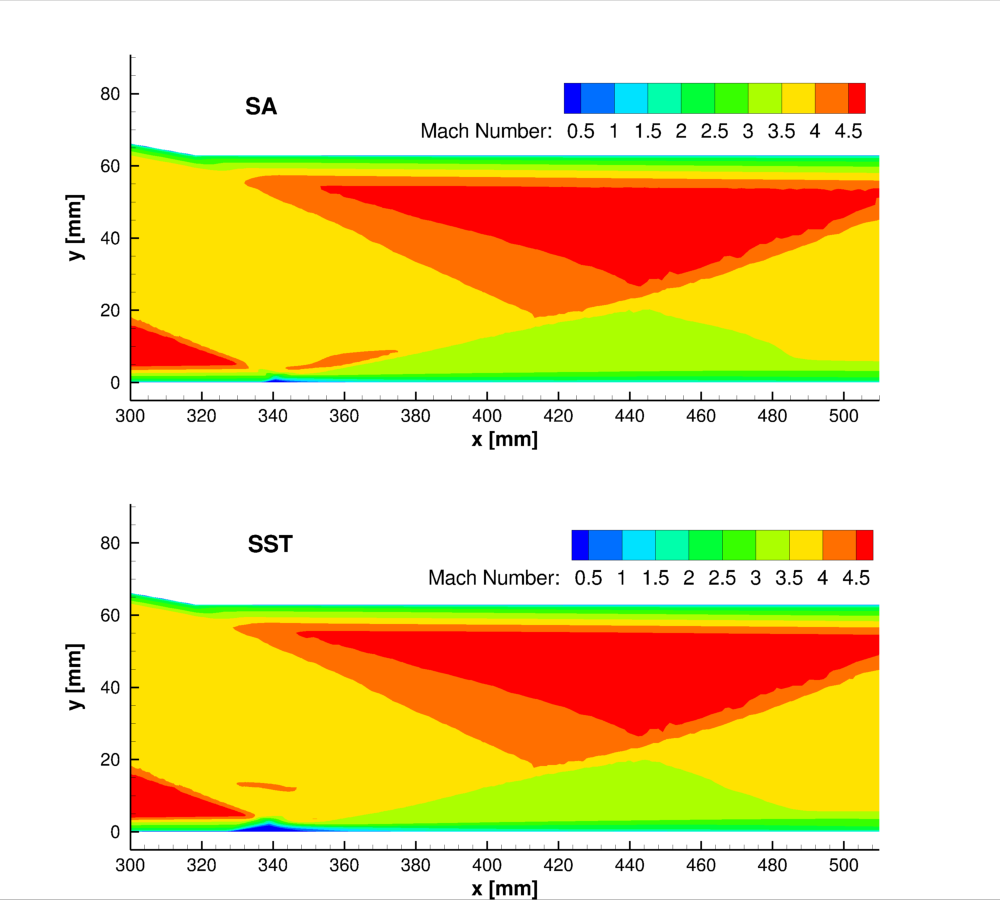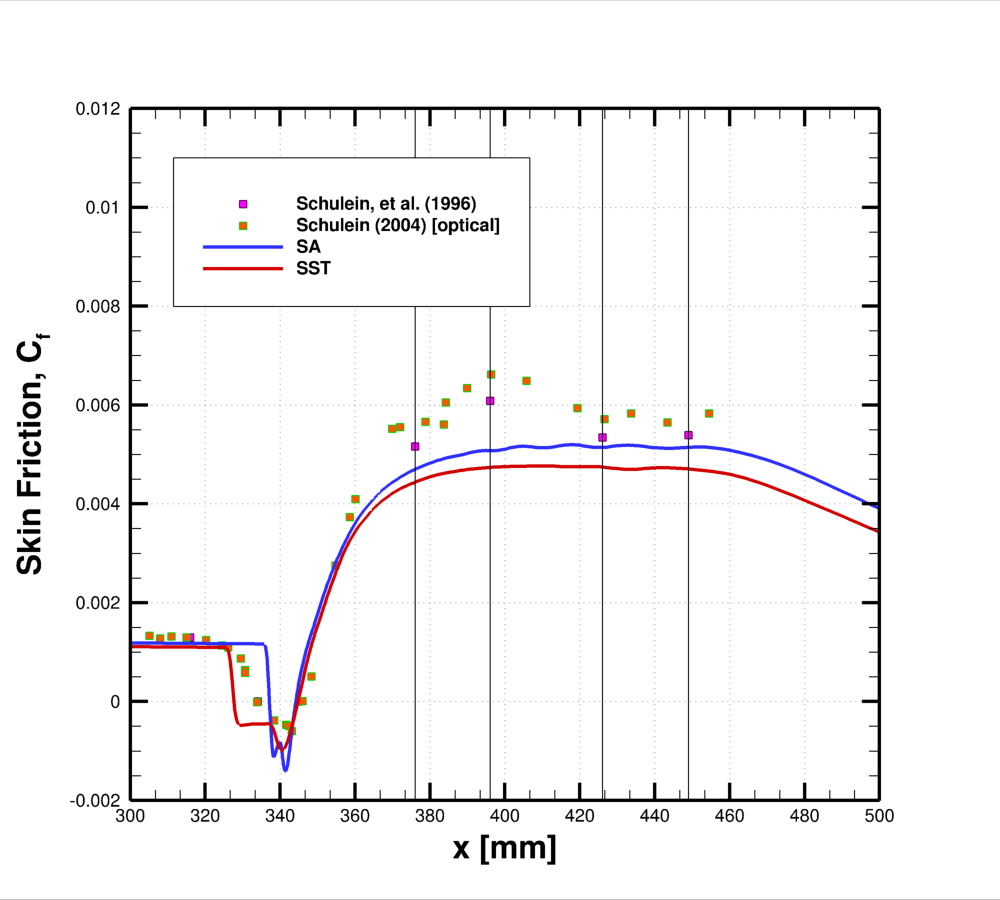
Figure 1: Unstructured grid
The following tar file is a complete package of grids, solutions, pre- and post-processing scripts, and experimental data used during the course of this validation study. Download the tar file and extract the folder to see the files.
| Wind-US 3.150 | |
|---|---|
| File | m5swbli1.tar |

Figure 1: Unstructured grid
This unstructured grid was created with a combination of structured and unstructured mesh elements. The near wall regions were packed with hexahedral layers of cells grown from the wall. Such a wall packing is necessary to resolve the boundary layer and near wall flow features. Therefore it is not recommended that tetrahedra be used to pack important boundary layer regions.
Away from walls, the grid transitions to isotropic tetrahedral cells in the core. High levels of skewness, rapid grid stretching, and abrupt transition from hexahedra to tetrahedra may adversely affect both the convergence characteristics of the solver, as well as the accuracy of a final converged solution. While structured and unstructured mesh elements were applied manually in this grid, most commercially available grid generators allow for an automated transition from near-wall to farfield regions.
This grid was created using Gridgen (swbli.gg) and exported in the Wind-US format (swbli.cgd). The single-zone unstructured grid was partitioned into multiple zones for parallel processing using cfpart tool. The input to the cfpart tool is also provided (cfpart.inp). The tool allows user to create lines which are required for the line Gauss-Seidel implicit solver, which is specified with the implicit keyword. Creating lines is important for viscous problems as it helps the convergence process by increasing the implicit coupling in the line direction and solving the system of equations "simultaneously". For this study, only lines were created and the grid was not partitioned.
| CFPART | Common Grid | Gridgen | |
|---|---|---|---|
| File | cfpart.inp | swbli.cgd | swbli.gg |
| Total Pressure (psia) | Total Temperature (R) | Mach Number | |
| Freestream | 307.48 | 738 | 5.0 |
Figure 2 shows the applied boundary conditions.

Figure 2: Boundary conditions
The calculations were performed using a first-order scheme for 1000 cycles. At which point, the second-order scheme was turned on and calculations were performed to convergence. Navier-Stokes and turbulence residuals were monitored to determine the convergence. Table 4 shows a list of algorithm settings used for the simulations and provided in the input files (sa.dat and sst.dat).
| Field | SA | SST |
|---|---|---|
| Version | Wind-US 3.150 | Wind-US 3.150 |
| Cycles | 1000 cycles first-order HLLE, remaining cycles second-order HLLE | |
| Convergence Order | 10 | 10 |
| Method | IMPLICIT UGAUSS LINE EXACT_LHS VISCOUS JACOBIAN FULL CONVERGE FREQUENCY 11 SUBITERATIONS 6 | |
| CFL | AUTO DECREASE 2 CFLMIN 1 CFLMAX 500 | AUTO DECREASE 2 CFLMIN 1 CFLMAX 100 |
| Limiters | DQ LIMITER ON RELAX 0.5 | |
| Dissipation | TVD BARTH 3.0 | |
| Boundaries | IMPLICIT BOUNDARY ON | |
| RHS | HLLE SECOND, VISCOUS THIN-LAYER | |
| Gradients | LEAST_SQUARES | |
| Turbulence | SPALART | SST |
| SA | SST |
|---|---|
| SA.dat | SST.dat |
Experimental skin friction and u-velocity data is available for comparison. However, only comparison with skin friction data is presented below due to restrictions on dissemination of the velocity data. The post processing scripts, regardless of the unavailability of the experimental velocity data, extracts calculated velocity data for turbulence model comparisons.
In order to compute u-velocity and skin friction for this case, two scripts must be used. First, "post_process", a bash script, will calculate the raw velocity and skin friction values. Next, "zsort", another bash script, will sort the u-velocity data so that it can be plotted correctly. A "results" folder must be created in the same directory as the "post_process" script. The skin friction and velocity data will be located in the "results" folder. "zsort" must be located in this "results" folder. The cgd and cfl files can be loaded into Tecplot using the Wind-US Common File Format Loader for further analysis. In Tecplot, "Calculate" function in "Analyze" menu can be used to calculate more variables and "Alter" function in "Data" menu can be used to rescale data.
The "post_process" script can also be used as a spawn script by simply setting FOR011 and FOR020 for grid and solution file respectively. Spawning the script at various intervals during the calcuation allows user to monitor convergence of a quantity like skin friction.
| Skin Friction and Velocity | Sort |
|---|---|
| post_process | zsort |
Figure 3 shows a comparison of Mach number contours for SA and SST turbulence models. As expected SA model predicts a smaller separation compared to the SST model. This behavior can also be seen in the skin friction plot, Figure 4. Although not shown here, the present predictions match well with the predictions obtained using structured Wind-US algorithm. Residuals were also monitored but not presented here for brevity.
 Figure 3: Mach contours comparison |
 Figure 4: Skin friction comparison |
Schulein, E., Krogmann, P., and Stanewsky, E., "Documentation of Two-Dimensional Impinging Shock/Turbulent Boundary Layer Interaction Flow", DLR Report DLR IB 223-96 A 49, October 1996.
This study was performed by Keven Lenahan and last updated on November 7, 2011 by Manan A. Vyas, who may be contacted at:
NASA Glenn Research Center
Inlets and Nozzles Branch
21000 Brookpark Road, M.S. 5-12
Cleveland, Ohio 44135
Phone: (216) 433-6053
e-mail: Manan.Vyas@nasa.gov